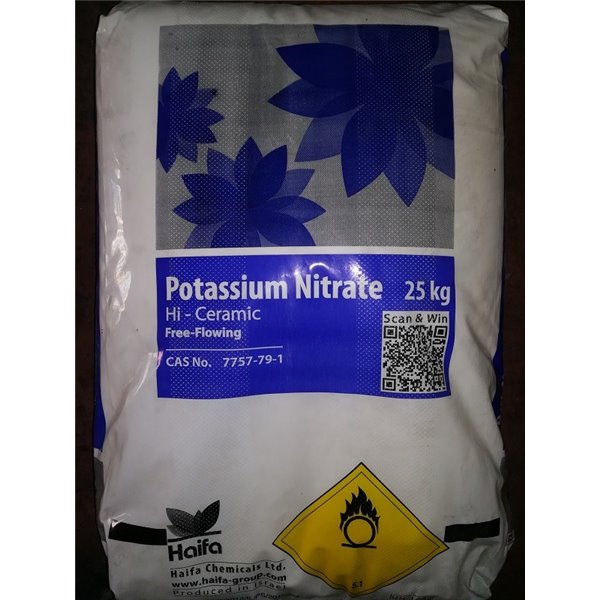POTASSIUM NITRATE ISRAEL
3.00 $
-
$ USD
CAS number: 7757-79-1
PubChem: 24434
ChemSpider: 22843
UNII: RU45X2JN0Z
UN number: 1486
KEGG: D02051
CHEMBL: 1644029
RTECS number: TT3700000
Molecular formula: KNO3
Molar mass: 101.1032 g / mol
Appearance: White solid
Odor: odorless
Density: 2.109 g / cm3 (16 ° C)
Melting point: 334 ° C
Boiling point: 400 ° C Decay.
General Information
KNO3 chemical formula in the old language, also known as salt water, in cold water very hot, very soluble in warm water, white in the form of this compound, naturally found in rocks and caves in crustacean form. It is not soluble in alcohol and it is not toxic, it does not have explosive property alone.
Although potassium nitrate normally dissolves in water, its solubility increases with temperature. The aqueous solution exhibits an almost neutrality (10% potassium nitrate solution is pH at 6.2 ° C at 6.2 ° C). It is not very hygroscopic. It is insoluble in alcohol and not toxic; Although it reacts with reducing agents, it does not have any explosive properties. Potassium nitrate, which is added as an additive to its hard structure after ceramic or clay processes, contributes with other chemicals.
Production and Reactions
The acid can be obtained by the base reaction.
HNO3 + KOH? KNO3 + H2O (80 0C)
Potassium nitrate is commercially produced by reaction of potassium chloride with sodium nitrate. When potassium nitrate is decomposed by heat, it releases oxygen. The solution can be obtained by double decomposition of the sodium nitrate and potassium chloride mixture. Potassium nitrate, which has a higher solubility and remains in solution, crystallizes as a result of cooling.
NaNO3 + KCl? KNO3 (solution) + NaCl (solid)
Another alternative to potassium nitrate production similar to the above reaction is the reaction based on a combination of ammonium nitrate and potassium chloride. Potassium nitrate, which is easily obtained by this reaction, does not contain sodium.
NH4NO3 + KCl? NH4Cl + KNO3
Potassium nitrate can be made by combining ammonium nitrate and potassium hydroxide.
NH4NO3 + KOH? NH3 (gas) + KNO3 + H2O
Potassium nitrate can also be produced by neutralizing nitric acid and potassium hydroxide. This reaction is very exothermic.
KOH (solution) + HNO3? KNO3 (solution) + H2O
Although potassium nitrate has an orthorhombic crystal structure at room temperature, it transforms into a trigonal crystal structure at 129 ° C. When heated to a temperature above 560 ° C, it decomposes into oxygen and potassium nitrite:
2 KNO3? 2 KNO2 + O2
Usage areas
Ceramic
It is used in the production of clay.It is hard after cooking at high temperatures.If it passes through other stages, a non-deformed structure is used as an additive to the ceramic which takes the form.
Pine
It is used as an additive to the amorphous structure of glass in this sector.


